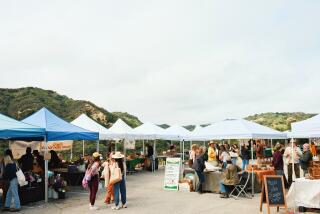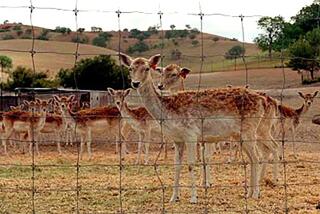New beef vendor at Santa Monica farmers market has history on its side
LOMPOC, Calif. — A new beef vendor at the Santa Monica farmers market, Rancho San Julian is very likely the oldest continuously operated family farm in California, dating to 1816, when José de la Guerra began to raise meat for the presidio at Santa Barbara. In 1837, the governor of Alta California granted him title to the ranch, which has remained in his family for nine generations. It currently extends over 13,000 acres of grasslands and oak forest, roamed by cougars, bears and hawks, and home to 500 Angus cows and their calves. All the cattle are born and raised on the ranch, fed chiefly on its dry-farmed grass, and not given corn, hormones or antibiotics.
Jim Poett, one of about 15 descendants who own the property, manages the ranch. His daughter, Elizabeth, 32, lives there in a 19th century adobe with two-foot-thick walls, and museum-like rooms with antique furniture and ancestral portraits. Four years ago she started selling her family’s beef at the Santa Barbara farmers markets, and since late June she’s been at Santa Monica every other Wednesday (she’ll be there Aug. 22). The meat is also available at Lindy and Grundy on Fairfax.
Until recently relatively little red meat was sold at California farmers markets, partly because there were few local, USDA-inspected slaughterhouses, which disappeared in recent decades as the meat and retail industries consolidated. To counter this trend and make local meat production viable again, the Central Coast Agriculture Cooperative now runs a “mobile harvest unit,” which humanely slaughters the cattle at Rancho San Julian, and transports the carcasses to a butcher in Paso Robles.
***
Inspired in part by the publication a decade ago of Amy Goldman’s exquisite book “Melons for the Passionate Grower,” there’s been a reawakening of interest in heirloom melons among home gardeners. To help build that momentum, Christian Dake of Baker Creek Heirloom Seed Co. planted several hundred varieties of melons and watermelons at a two-acre plot in Esparto, a hotspot of organic farming northwest of Sacramento. His primary purpose is to offer them for exhibit, tasting and sale at the National Heirloom Exposition in Santa Rosa on Sept. 11-13, but as it turned out, many of the melons ripened early. He mentioned this to Diana Rodgers, who both farms flowers in Petaluma and manages the Mar Vista farmers market, and she invited him to drive his super-abundance south.
Dake will sell about 50 varieties of melons and watermelons at the Mar Vista farmers market this Sunday (Aug. 19) only. Many are rare, such as Noire de Carmes, a true ribbed cantaloupe with a complex musky flavor; Thai apple melon, which seems like a cross of honeydew and Asian pear; and Congo watermelon, with deep red-orange flesh and an intense tropical taste.
“The idea is that if more people were exposed to these heirloom melons, they might get back to markets, and this might help to preserve their diversity,” said Dake, 33, who grew up on a farm in Napa Valley.
To add to the allure, Jeremy Fox, renowned for his Michelin-starred vegetarian cooking at Ubuntu in Napa, and who will soon be opening Barnyard in Venice, will help offer samples of Dake’s melons at about 11 a.m., and samples of a soup he will make from them from 11:30 a.m. to 1 p.m.
***
Some mild-flavored fruit, such as Calimyrna figs, are better dried than fresh, because their flavor is more pleasing when concentrated. A prime example is the “white” mulberry (Morus alba, tut in Farsi), which is sweet but rather bland as a fresh fruit but has an attractive honeyed, raisin-y flavor when dried. What about its noble cousin, the black or Persian mulberry (M. alba, shah tut), which already has the most intense flavor of any berry when fresh?
The question has been moot at farmers markets, since Persian mulberries always have been too rare and expensive for drying. But recently Weiser Family Farms has made up a small batch, and at Santa Monica next Wednesday a few shoppers will have a chance to buy and taste them. Based on a sample last week, the small, dark, tarry lumps won’t win any beauty prizes, but the flavor is so amplified, it may be worth the price of $10 or $12 for a 4-ounce bag. I wouldn’t gobble a whole bag at a sitting but rather reserve them for special occasions, as fruitarian petits fours, or as a party trick to impress fruit maven friends.
***
Tips of the week: Adriatic figs grown by Mark Boujikian in Raisin City, with rich, sweet-tart pulp like strawberry jam, at farmers markets in Torrance (both Saturday and Tuesday), Irvine, Hollywood, Encino, Playa Vista and Hawthorne; seeded Muscat of Alexandria grapes, with an intense floral aroma, from Scott Farms at Mar Vista and Santa Monica on Wednesday.
More to Read
Eat your way across L.A.
Get our weekly Tasting Notes newsletter for reviews, news and more.
You may occasionally receive promotional content from the Los Angeles Times.






